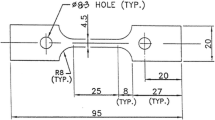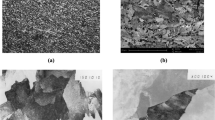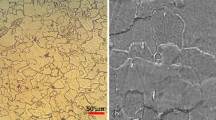Abstract
In the flux cored arc welding of high-Mn steels, the effects of the welding position and heat input on the dilution rate and mechanical properties were investigated using an austenitic stainless steel filler with a lower strength than that of the base metal. Horizontal (2G) and vertical-up (3G-UP) position welding was conducted under low- and high-heat input conditions. The 3G-UP welding position had a higher dilution rate than the 2G welding position, and the yield strength and tensile strength were relatively high at appropriate heat input rather than excessive heat input in 3G-UP. A fully austenitic microstructure with a dendritic structure was primarily observed, and oxide inclusions were observed in the weld metal. The primary dendrite arm spacing was dependent on the heat input rather than on the chemical composition. From the multiple regression model based on the chemical composition and heat input, the strength of the weld metal was determined mainly by monitoring the welding heat input and C, Cu, Mo, and Cr contents. The soundness of high-Mn steel welds with an under-matched filler was confirmed to fulfill the mechanical property requirements for cryogenic applications regardless of the welding position and heat input, and an empirical model to estimate the strength of high-Mn welds was established as follows: Yield Strength (MPa) = 297.7 + 382 × C + 23.2 × Mo + 2.93 × Cr + 438 × Cu – 2.58 × Heat Input (HI).
















Similar content being viewed by others
Abbreviations
- LNG:
-
Liquefied natural gas
- ASTM:
-
American Society for Testing and Materials
- FCA:
-
Flux cored arc
- 2G-L:
-
2G position/low heat input
- 2G-H:
-
2G position/high heat input
- 3G-L:
-
3G position/low heat input
- 3G-H:
-
3G position/high heat input
- NDE:
-
Nondestructive examination
- RT:
-
Radiographic testing
- RH:
-
Relative humidity
- OES:
-
Optical emission spectroscopy
- OM:
-
Optical microscopy
- SEM:
-
Scanning electron microscopy
- EDS:
-
Energy-dispersive X-ray spectroscopy
- EBSD:
-
Electron backscatter diffraction
- HV:
-
Vickers hardness value
- IMO:
-
International Maritime Organization
- PDAS:
-
Primary dendrite arm spacing
- UGC:
-
Unique grain color
- R2 :
-
The coefficient of determination
- D:
-
Dilution rate
- Cw :
-
Elemental compositions of the weld metal
- Cwc :
-
Elemental compositions of the welding consumables
- Cb :
-
Elemental compositions of the base metal
References
Kim BE, Park JY, Lee JS, Lee JI, Kim MH (2019) Effects of the welding process and consumables on the fracture behavior of 9 wt.% nickel steel. Exp Tech 44(2):175–186. https://doi.org/10.1007/s40799-019-00321-3
Kim TY, Yoon SW, Kim JH, Kim MH (2021) Fatigue and fracture behavior of cryogenic materials applied to LNG fuel storage tanks for coastal ships. Metals 11(12):1–15. https://doi.org/10.3390/met11121899
Park TU, Jeong YC, Im HD, Choi CH, Kil W (2022) Development and Evaluation of Stainless Steel-Base Flux-Cored Wires for 9% Nickel Steel. JWJ 40(5):367–376. https://doi.org/10.5781/jwj.2022.40.5.1
Avery RE, Parsons D (1995) Welding stainless and 9% nickel steel cryogenic vessels. Weld J 74(11):45–50
Hilkes J, Neessen F (2007) Welding 9% nickel steel for liquefied natural gas (LNG) applications. Weld Cut 2:103–112
De Cooman BC, Chen L, Kim HS, Estrin Y, Kim SK, Voswinckel H (2009) Microstructure and texture in steels. Springer, London
Keil D, Zinke M, Pries H (2011) Weldability of novel Fe-Mn high-strength steels for automotive applications. Weld World 55(11):21–30. https://doi.org/10.1007/BF03321539
Bleck W (2021) New insights into the properties of high-manganese steel. Int J Miner Metall Mater 28(5):782–796. https://doi.org/10.1007/s12613-020-2166-1
Wesselmecking S, Song W, Bleck W (2022) Dynamic and Static Strain Aging in a High-Manganese Steel. Steel Res Int 93(7):2100707. https://doi.org/10.1002/srin.202100707
De Cooman BC, Kwon O, Chin KG (2012) State-of-the-knowledge on TWIP steel. Mater Sci Technol 28(5):513–527. https://doi.org/10.1179/1743284711y.0000000095
Park G, Jeong S, Lee C (2020) Fusion weldabilities of advanced high manganese steels: a review. Met Mater Int 27(7):2046–2058. https://doi.org/10.1007/s12540-020-00706-9
Xiong R, Liu Y, Si H, Peng H, Wang S, Sun B, Chen H, Kim HS, Wen Y (2021) Effects of Si on the microstructure and work hardening behavior of Fe-17Mn-1.1C-xSi high manganese steels. Met Mater Int 27(10):3891–3904. https://doi.org/10.1007/s12540-020-00846-y
Chou CP, Lee CH (1989) The influence of carbon content on austenite-ferrite morphology in Fe-Mn-Al weld metals. Metall Trans A 20(11):2559–2561
Chou CP, Lee CH (1990) Effect of carbon on the weldability of Fe-Mn-Al alloys. J Mater Sci 25(2):1491–1496
Yoo J, Han K, Park Y, Choi J, Lee C (2014) Evaluation of solidification cracking susceptibility of Fe-18Mn-0·6C steel welds. Sci Technol Weld Join 19(6):514–520. https://doi.org/10.1179/1362171814y.0000000216
Yoo J, Kim B, Park Y, Lee C (2015) Microstructural evolution and solidification cracking susceptibility of Fe-18Mn-0.6C-xAl steel welds. J Mater Sci 50(1):279–286. https://doi.org/10.1007/s10853-014-8586-4
Yoo J, Kim B, Jeong Y, Park Y, Lee C (2015) Influence of Cr on weld solidification cracking in Fe-15Mn-0.5C-3.5Al-xCr alloys. ISIJ Int 55(1):257–263. https://doi.org/10.2355/isijinternational.55.257
Kang M, Kim YM, Han HN, Kim C (2017) Effects of phase evolution on mechanical properties of laser-welded ferritic Fe-Al-Mn-C steel. Metals 7(12):523. https://doi.org/10.3390/met7120523
Kim B, Lee SG, Kim DW, Jo YH, Bae J, Sohn SS, Lee S (2020) Effects of Ni and Cu addition on cryogenic-temperature tensile and charpy impact properties in austenitic 22Mn-0.45C-1Al steels. J Alloy Compd 815:152407. https://doi.org/10.1016/j.jallcom.2019.152407
Choi M, Lee J, Nam H, Kang N, Kim M, Cho D (2020) Tensile and microstructural characteristics of Fe-24Mn steel welds for cryogenic applications. Met Mater Int 26(2):240–247. https://doi.org/10.1007/s12540-019-00320-4
Fan X, Li Y, Qi Y, Cai X, Wang Z, Ma C (2021) Mechanical properties of cryogenic high manganese steel joints filled with nickel-based materials by SMAW and SAW. Mater Lett 304:130596. https://doi.org/10.1016/j.matlet.2021.130596
ASTM International (2017) ASTM A1106/A1106M:2017 Standard specification for pressure vessel plate, alloy steel, austenitic high manganese for cryogenic application. ASTM International, West Conshohocken
Park TU, Jung DH, Park JH, Kim JH, Han IW (2022) Changes in the mechanical properties and microstructure of high manganese steel by high heat input welding and general welding processes. JWJ 40(1):33–39. https://doi.org/10.5781/jwj.2022.40.1.4
Park G-W, Park M, Kim BJ, Shin S, Kim HC, Park I-W, Park SS, Jeon JB (2022) Microstructure and mechanical properties of a gas-tungsten-arc-welded Fe-24Mn-3.5Cr-0.4C high manganese steel pipe using a Fe-22Mn-2.34Ni-0.38C welding wire. Mater Charact 194:112469. https://doi.org/10.1016/j.matchar.2022.112469
Park M, Kang M, Park G-W, Jang G, Kim B, Kim HC, Jeon JB, Kim H, Kwon S-H, Kim BJ (2022) The effects of post weld heat treatment for welded high-Mn austenitic steels using the submerged arc welding method. J Mater Res Technol 18:4497–4512. https://doi.org/10.1016/j.jmrt.2022.04.103
Gonser M, Lippold J, Dickinson D, Sowards J, Ramirez A (2010) Characterization of welding fume generated by high-Mn consumables. Weld J 89(2):25s–33s
Han K, Yoo J, Lee B, Han I, Lee C (2014) Effect of Ni on the hot ductility and hot cracking susceptibility of high Mn austenitic cast steel. Mater Sci Eng A 618:295–304. https://doi.org/10.1016/j.msea.2014.09.040
Ueda K, Yamashita S, Takada A, Sahara N, Ogura T, Saida K (2021) Characterization of hot cracking in multi-pass weld metal of high manganese austenitic steel. Weld Int 34(10–12):388–398. https://doi.org/10.1080/09507116.2021.1922000
Park WS, Yoo SW, Kim MH, Lee JM (2010) Strain-rate effects on the mechanical behavior of the AISI 300 series of austenitic stainless steel under cryogenic environments. Mater Des 31(8):3630–3640. https://doi.org/10.1016/j.matdes.2010.02.041
Yang W, Kil W, Moon B, Nam H, Kang N (2020) Tensile and microstructural behaviors of austenitic stainless steel GTA welds for cryogenic application. JWJ 38(4):400–408. https://doi.org/10.5781/jwj.2020.38.4.10
Karjalainen LP, Taulavuori T, Sellman M, Kyröläinen A (2008) Some strengthening methods for austenitic stainless steels. Steel Res Int 79(6):404–412. https://doi.org/10.1002/srin.200806146
Valiente Bermejo MA, Karlsson L, Svensson LE, Hurtig K, Rasmuson H, Frodigh M, Bengtsson P (2015) Effect of welding position on properties of duplex and superduplex stainless steel circumferential welds. Weld World 59(5):693–703. https://doi.org/10.1007/s40194-015-0245-0
Tasalloti H, Kah P, Martikainen J (2017) Effect of heat input on dissimilar welds of ultra high strength steel and duplex stainless steel: Microstructural and compositional analysis. Mater Charact 123:29–41. https://doi.org/10.1016/j.matchar.2016.11.014
Tümer M, Vallant R, Warchomicka FG, Enzinger N (2022) Undermatched welding of ultra-high-strength steel S1100 with metal-cored wire: influence of welding positions on mechanical properties. J Mater Eng Perform 31(9):7068–7079. https://doi.org/10.1007/s11665-022-06876-4
Bang KS, Jung DH, Park C, Chang WS (2013) Effects of welding parameters on tensile strength of weld metal in flux cored arc welding. Sci Technol Weld Join 13(6):509–514. https://doi.org/10.1179/174329307x249397
Kim IC, Jeong SH, Choi HG, Kim MH (2018) Study on the fracture toughness of FCA weldment with the yield strength 420MPa grade high strength steels for offshore structures depending on the welding position. JWJ 36(2):67–73. https://doi.org/10.5781/jwj.2018.36.2.10
Di X, Deng S, Wang B (2015) Effect of pulse current on mechanical properties and dendritic morphology of modified medium manganese steel welds metal. Mater Des 66:169–175. https://doi.org/10.1016/j.matdes.2014.10.050
Lee Y, Nordin M, Babu SS, Farson DF (2014) Effect of fluid convection on dendrite arm spacing in laser deposition. Metall Mater Trans B 45(4):1520–1529. https://doi.org/10.1007/s11663-014-0054-7
Qiu Z, Wu B, Zhu H, Wang Z, Hellier A, Ma Y, Li H, Muransky O, Wexler D (2020) Microstructure and mechanical properties of wire arc additively manufactured Hastelloy C276 alloy. Mater Des 195:109007. https://doi.org/10.1016/j.matdes.2020.109007
Lee C, Lee Y, Lee C, Hong S (2018) Precipitation behavior of the sigma phase with Ni and Mn content variations in superaustenitic stainless steel weld metal. Mater Charact 144:148–154. https://doi.org/10.1016/j.matchar.2018.07.006
Sieurin H, Zander J, Sandström R (2006) Modelling solid solution hardening in stainless steels. Mater Sci Eng A 415(1–2):66–71. https://doi.org/10.1016/j.msea.2005.09.031
Booker MK, Sikka VK (1977) Effects of composition variables on the tensile properties of Type 304 stainless steel. Report No. CONF-771140-1, Oak Ridge National Laboratory, Oak Ridge
Ohkubo N, Miyakusu K, Uematsu Y, Kimura H (1994) Effect of alloying elements on the mechanical properties of the stable austenitic stainless steel. ISIJ Int 34(9):764–772. https://doi.org/10.2355/isijinternational.34.764
Banovic SW, DuPont IN, Marder AR (2001) Dilution control in gas-tungsten-arc welds involving superaustenitic stainless steels and nickel-based alloys. Metall Mater Trans B 32(6):1171–1176. https://doi.org/10.1007/s11663-001-0104-9
Ogawa T, Koseki T (1988) Weldability of newly developed austenitic alloys for cryogenic service: Part II - high-nitrogen stainless steel weld metal. Weld J 67(1):8s–17s
Szumachowski ER, Reid HF (1979) Cryogenic toughness of SMAW austenitic stainless steel weld metals: Part II - role of nitrogen. Weld J 58(2):34s–44s
Bennett WS, Mills GS (1974) GTA weldability studies on high manganese stainless steel. Weld J 53(12):548s–553s
Woo I, Kikuchi Y (2002) Weldability of high nitrogen stainless steel. ISIJ Int 42(12):1334–1343. https://doi.org/10.2355/isijinternational.42.1334
Tümer M, Yılmaz R (2016) Characterization of microstructure, chemical composition, and toughness of a multipass welded joint of austenitic stainless steel AISI316L. Int J Adv Manuf Technol 87(9):2567–2579. https://doi.org/10.1007/s00170-016-8614-4
Baker I (2022) Interstitial strengthening in f.c.c. metals and alloys. Adv Powder Mater 1(4):100034. https://doi.org/10.1016/j.apmate.2022.100034
Berns H, Gavriljuk V, Shanina B (2008) Intensive Interstitial Strengthening of Stainless Steels. Adv Eng Mater 10(12):1083–1093. https://doi.org/10.1002/adem.200800214
Kim C, Ahn Y, Lee KB, Kim D (2016) High-deposition-rate position welding of Al 5083 alloy for spherical-type liquefied natural gas tank. Proc Inst Mech Eng Part B J Eng Manuf 230(5):818–824. https://doi.org/10.1177/0954405414563553
Korean Standards Association (2019) KS D 7143:2019 Flux cored arc welding wire for high manganese steel plate. Korean Standards Association, Seoul
Funding
This work was supported by the Korea Institute for Advancement of Technology grant funded by the Korean Government (The Ministry of Trade, Industry, and Energy) (P0023676, HRD Program for Industrial Innovation).
Author information
Authors and Affiliations
Contributions
All authors contributed to the study conception and design. Material preparation and data collection were performed by Sukil Park, Juyeon Won, and Seungmin Yoo. Analysis was performed by Sukil Park, Byungrok Moon, and Juyeon Won. The whole investigation was advised by Cheolhee Kim and Namhyun Kang. The first draft of the manuscript was written by Sukil Park, and all authors commented on previous versions of the manuscript. All authors read and approved the final manuscript.
Corresponding authors
Ethics declarations
Competing interests
The authors have no relevant financial or non-financial interests to disclose.
Additional information
Publisher's note
Springer Nature remains neutral with regard to jurisdictional claims in published maps and institutional affiliations.
Appendix
Appendix
1.1 Experimental data for the yield strength model
Fifteen data points were used to establish a multiple regression model for predicting the strength of the weld metal based on the chemical composition and heat input. In Tests 1–4, high-Mn and austenitic stainless steels were used as the base and filler metals, respectively, as specified in Section 2.1. The measured data are shown in Fig. 4 and Tables 2 and 3. In tests 5–15, the base metals were high-Mn steel, stainless steel, and 9% Ni steel, whereas the filler metal was austenitic stainless steel. The chemical composition and strength were measured according to the procedure described in Section 2.2. The heat input varied between 10–37.4 kJ/cm in the dataset.
Table
Rights and permissions
Springer Nature or its licensor (e.g. a society or other partner) holds exclusive rights to this article under a publishing agreement with the author(s) or other rightsholder(s); author self-archiving of the accepted manuscript version of this article is solely governed by the terms of such publishing agreement and applicable law.
About this article
Cite this article
Park, S., Won, J., Yoo, S. et al. Influence of welding position and dilution on mechanical properties and strengthening design of flux cored arc weld metal for high manganese steels. Int J Adv Manuf Technol 130, 3509–3523 (2024). https://doi.org/10.1007/s00170-023-12765-4
Received:
Accepted:
Published:
Issue Date:
DOI: https://doi.org/10.1007/s00170-023-12765-4




